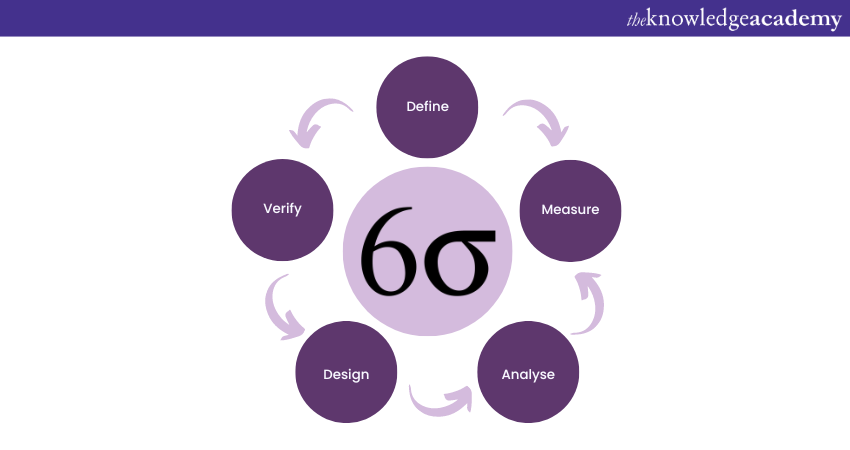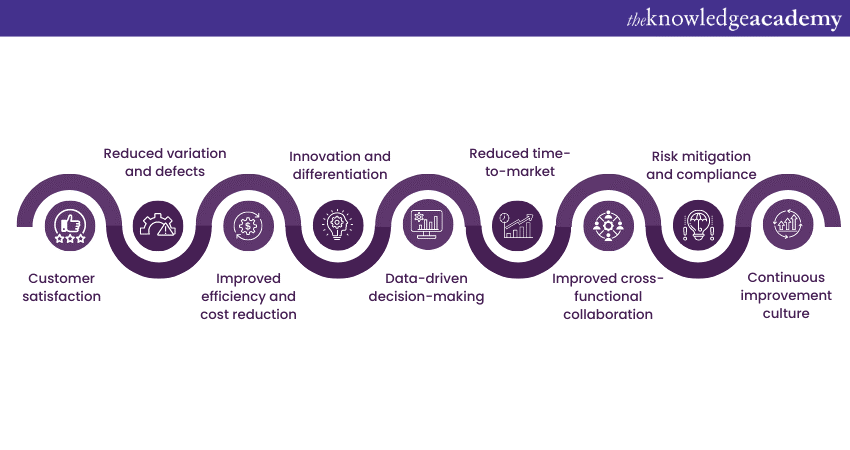We may not have the course you’re looking for. If you enquire or give us a call on 01344203999 and speak to our training experts, we may still be able to help with your training requirements.
Training Outcomes Within Your Budget!
We ensure quality, budget-alignment, and timely delivery by our expert instructors.

With increasing competition in the market, organisations strive to deliver superior products and services while minimising defects and waste. This is where Design for Six Sigma (DFSS) comes into play.
DFSS focuses on developing new products, processes, or services to meet customer needs and achieve high quality. So, if you want to improve your business processes and derive success, it’s time to get familiar with DFSS.
Don’t know what DFSS is, how it works, and how it can benefit your organisation? Well, we’ll help you put an end to these questions. Read this blog to learn about Design for Six Sigma and embark on a journey towards designing exceptional products and processes.
Table of Contents
1) What is Design for Six Sigma (DFSS)?
2) Why to use Design for Six Sigma (DFSS)?
3) When to use Design for Six Sigma (DFSS)?
4) How to implement Design for Six Sigma (DFSS)?
5) Key concepts of Design for Six Sigma (DFSS)
6) DFSS vs. DMAIC vs. DMADV
7) Tools and techniques in Design for Six Sigma
8) Key benefits of Design for Six Sigma (DFSS)
9) Conclusion
What is Design for Six Sigma (DFSS)?
Design for Six Sigma (DFSS) is a powerful methodology combining Six Sigma and Design Thinking principles to create innovative, high-quality products and processes. It is a proactive approach that addresses potential defects and failures in the design stage, ensuring that customer requirements are met with minimal variation.
At its core, DFSS emphasises the importance of understanding the Voice of the Customer (VOC). It involves the following:
a) Actively listening to customers
b) Gathering feedback
c) Conducting market research
d) Translating those insights into specific design requirements
Further, this methodology focuses on eliminating or minimising defects and variations in product or process design. By doing so, organisations can achieve consistent quality, reduce waste, enhance efficiency, and ultimately improve customer satisfaction.
Therefore, it assists organisations in developing products and processes that align with customer expectations. It also allows them to deliver superior value services.

Why to use Design for Six Sigma (DFSS)?
DFSS aims to develop products, services or processes that are user centric from the beginning. Here are few reasons why you can use DFSS :
1) Customer satisfaction: It understand customers' needs and aims to deliver products or services that is tailored to them.
2) Increases efficiency: Six Sigma reduces defects and streamlines operations. This increases efficiency in delivering the products or services.
3) Innovation: This allows you to create new ideas and think about solutions which are not common.
4) Decreases errors: All the projects that have the potential of making errors, can be reduced by using Six Sigma.
5) Seamless collaboration: Using it, enables you to seamlessly collaborate across all team members, and complete the products or services in record time.
Gain a comprehensive understanding of Six Sigma with our - Six Sigma Yellow Belt Course
When to use Design for Six Sigma (DFSS)?
Unlike traditional Six Sigma, which emphasises on improving existing processes, DFSS gets it right from the beginning. Here are instances when DFSS should be employed:
1) New product: DFSS helps to make sure that customer expectations and requirements are met, when the organisation introduces any new product or services.
2) Redesign of existing product: When a new product or service is not at par with customer requirements, then DFSS has the ability to redesign that product or service, which will suit the customers’ needs.
3) New process creation: Like DFSS ensures that new products are at par with user needs, it also takes care of any new processes that are being introduced by the company.
4) Major changes in business strategy: DFSS makes the necessary improvements if there is any change in the business strategy of the organisation.
5) Technological advancements: Any new changes in the technology are efficiently brought about by DFSS to ensure that they are optimised according to user needs.
How to Implement Design for Six Sigma (DFSS)?
The Design for Six Sigma Methodology follows a structured approach that consists of several distinct phases. Each phase is crucial in ensuring the successful design and development of high-quality products and processes. The following are the phases of the DFSS process:

Define phase
In the Define phase, the project goals, scope, and objectives are clearly defined. This includes the following:
a) Identifying the customer requirements
b) Establishing project boundaries
c) Forming a cross-functional team responsible for the design process
The Define phase sets the foundation for the entire DFSS journey and ensures alignment with customer needs.
Measure phase
During the Measure phase, the focus is on the following:
a) Gathering data and conducting a thorough analysis of the current state
b) Identifying critical-to-quality (CTQ) parameters
c) Understanding process capabilities
d) Assessing potential sources of variation
By measuring and understanding the existing performance, teams can establish a baseline for improvement and identify focus areas.
Analyse phase
In the Analyse phase, the gathered data is analysed to identify the root causes of performance gaps and potential design issues. Tools such as root cause analysis, hypothesis testing, and statistical techniques are employed to pinpoint.
These tools significantly impact the outcomes. The Analyse phase provides insights into the relationships between variables and guides subsequent design decisions.
Design phase
The Design phase involves developing innovative solutions based on the insights gained from the previous phases. It focuses on translating customer requirements into specific design characteristics. At the same time, it considers constraints such as cost, feasibility, and manufacturability.
Also, tools like Quality Function Deployment (QFD), Failure Modes and Effects Analysis (FMEA), and Design of Experiments (DOE) are employed to refine the design and optimise its performance.
Verify phase
In the Verify phase, the designed solution is thoroughly tested and validated against the customer’s requirements. This includes conducting simulations, prototypes, and pilot studies to assess the performance, functionality, and reliability of the design.
Further, verification ensures that the design meets the desired specifications and meets customer expectations.
Learn how to implement the Six Sigma to achieve business objectives with our -Six Sigma Black Belt Course now
Key Concepts of Design for Six Sigma (DFSS)
DFSS signifies the design of the products or services to achieve the highest performances. Here are some key concepts of DFSS:
1) Customer-centric focus: The design should cater to customer needs and specifications. Designers employ tools like Quality Function Deployment (QFD) to translate customer requirements into specific design features.
2) Robust design: When you create products, your main focus is to create such a design that is both robust and useful.
3) Simulation and prototyping: In this process the emphasis is on the use of simulations and prototypes to validate design performance for your company’s goals.
4) Voice of the Customer (VOC): To understand the voice of the customer it is imperative that you get to know what the customer wants and their basic needs.
5) IDOV Methodology: IDOV stands for Identify, Design, Optimise, and Verify. It's one of the most popular methodologies in DFSS. In this methodology you can start by identifying the customer needs, designing the process and optimising for peak performance, and verifying the design against the original specifications.
6) Concept, Architect, Process, Design, Optimise (CAPDO): Another methodology used in DFSS, signifies architectural decisions, process design, detailed design, and optimisation.
7) Risk management: Potential risks are identified, evaluated, and mitigated during the design phase. This approach reduces the chances of defects or failures when the product or process is rolled out.
8) Metrics-driven decision-making: In DFSS, decisions are made based on quantifiable metrics. The primary metric is the Sigma level, which measures the capability of the design process.
9) Continuous improvement: Even after the completion of the products or services, it aims to continue to seek improvement for better customer experience.
DFSS v. DMAIC v. DMADV
After learning about DFSS in detail, it’s time to learn about these three methodologies, to help you generate better results for your company. Let's explore the difference between DFSS, DMAIC and DMADV:
DFSS/DMADV
DFSS is a methodology in Six Sigma used to design and redesign products or services. This methodology is very commonly used in organisations to help them achieve customer satisfaction and increase their brand reputation.
The Define, Measure, Analyse, Design, Verify (DMADV) is another methodology which is sometimes interchangeably used in place of DFSS. In this methodology, it mainly focuses on creating new products or services to get optimal performance from the beginning of any project.
DMAIC
In this methodology, it mainly focuses on improving existing processes. It also helps you and your team to identify and rectify defects from projects or services which are already created. Another goal is that it also helps you to enhance the current undergoing processes in Six Sigma. You can use DMAIC to improve the existing processes, when the standard services or products are not generating the intended results or customer satisfaction.
While choosing between DFFS and DMAIC, consider if the service has already been implemented. If yes, then DMAIC should be used for the further process. However, if the product and service does not currently exist, DMADV approach should be used.
Tools and techniques in Design for Six Sigma
DFSS leverages various tools and techniques to drive innovation, improve quality, and meet customer expectations. These tools and techniques play a vital role in each phase of the Design for Six Sigma process, aiding in the design and development of robust products and processes. Let’s explore some of the key tools and techniques used in DFSS:
a) Quality Function Deployment (QFD): Translates customer requirements into specific design features and characteristics, ensuring alignment between customer expectations and design decisions.
b) Failure Modes and Effects Analysis (FMEA): Systematically identifies potential failure modes, assesses their impact, and develops mitigation strategies to enhance product reliability and quality.
c) Design of Experiments (DOE): Conducts controlled experiments to investigate the relationship between design variables and output responses, facilitating optimisation and data-driven decision-making.
d) Critical-to-Quality (CTQ) Analysis: Identifies the key parameters that impact product quality and customer satisfaction, enabling focused improvement efforts.
e) Statistical Process Control (SPC): Monitors and controls process variations using statistical methods, ensuring consistent quality and reducing defects.
f) Tolerance analysis: Evaluates the impact of variations in design dimensions and tolerances on product performance, ensuring robustness and manufacturability.
g) Simulation and modelling: Utilises computer-based simulations and models to test and optimise the design before physical implementation, saving time and costs.
h) Robust Design techniques: Develop designs resistant to variations and external factors, delivering consistent performance and reliability.
i) Value Analysis/Value Engineering (VA/VE): Identifies opportunities to enhance value by optimising the cost-to-performance ratio of design features and functions.
j) Pugh matrix: Facilitates decision-making by systematically evaluating and comparing design alternatives against multiple criteria.
k) Theory of Inventive Problem Solving (TRIZ): Provides a systematic approach for solving complex design problems by leveraging inventive principles and patterns.
l) Prototyping and rapid prototyping: Creates physical or digital prototypes to validate design concepts, gather feedback, and iterate on the design.
Understand how to perform root cause analysis during the project lifecycle. Register for our DMAIC Training.
Key benefits of Design for Six Sigma (DFSS)
Organisations seeking to improve their product and process design can enjoy the several benefits that Design for Six Sigma provides. It enables businesses to achieve excellence and gain a competitive edge. Here are some of the key benefits of implementing DFSS:

a) Customer satisfaction: DFSS strongly emphasises understanding and incorporating the Voice of the Customer (VOC) into the design process. This helps ensure that products and processes deliver high levels of customer satisfaction and meet or exceed their expectations.
b) Reduced variation and defects: It encourages identifying potential failure modes, conducting rigorous analysis, and implementing robust design techniques. Therefore, DFSS reduces the likelihood of errors, improves reliability, and enhances overall product quality.
c) Improved efficiency and cost reduction: The methodology optimises design decisions by considering cost, efficiency, and manufacturability. Therefore, it helps organisations achieve cost savings and improve operational efficiency.
d) Innovation and differentiation: It allows leveraging tools such as Quality Function Deployment (QFD), Design of Experiments (DOE), and robust design techniques. Therefore, DFSS enables the development of unique and differentiated products and processes that stand out in the market.
e) Data-driven decision-making: DFSS also assists organisations in gaining insights into the factors that impact design performance. It also helps them make informed decisions based on objective evidence, improving outcomes.
f) Reduced time-to-market: DFSS promotes efficiency and effectiveness in the design process, enabling organisations to bring products and processes to market faster. It helps accelerate the time-to-market and gain a competitive advantage.
g) Improved cross-functional collaboration: This promotes better communication, knowledge sharing, and synergy among team members, leading to enhanced collaboration and more effective problem-solving.
h) Risk mitigation and compliance: DFSS includes tools like Failure Modes and Effects Analysis (FMEA) that help identify and mitigate potential risks in the design stage. By proactively addressing risks and compliance requirements, organisations can ensure that their designs meet safety standards, regulatory guidelines, and industry-specific requirements.
i) Continuous improvement culture: DFSS fosters a mindset of continuous improvement and strives for excellence in design and development.
Conclusion
By harnessing the power of Design for Six Sigma and its tools and techniques, you can unlock the potential to deliver exceptional products and processes. This will help you exceed customer expectations. So, embrace the mindset of continuous improvement, harness the voice of the customer, and let DFSS propel your organisation towards sustainable success.
Ready to take your Lean Six Sigma skills to the next level? Register now for our Lean Six Sigma Green Belt Course now!
Frequently Asked Questions
Upcoming Business Improvement Resources Batches & Dates
Date
 Six Sigma Green Belt
Six Sigma Green Belt
Mon 13th May 2024
Sat 18th May 2024, Sun 19th May 2024
Mon 20th May 2024
Tue 28th May 2024
Mon 3rd Jun 2024
Mon 10th Jun 2024
Mon 17th Jun 2024
Sat 22nd Jun 2024, Sun 23rd Jun 2024
Mon 24th Jun 2024
Mon 1st Jul 2024
Mon 8th Jul 2024
Mon 15th Jul 2024
Sat 20th Jul 2024, Sun 21st Jul 2024
Mon 22nd Jul 2024
Mon 29th Jul 2024
Mon 5th Aug 2024
Mon 12th Aug 2024
Sat 17th Aug 2024, Sun 18th Aug 2024
Mon 19th Aug 2024
Tue 27th Aug 2024
Mon 2nd Sep 2024
Mon 9th Sep 2024
Sat 14th Sep 2024, Sun 15th Sep 2024
Mon 16th Sep 2024
Mon 23rd Sep 2024
Mon 30th Sep 2024
Mon 7th Oct 2024
Sat 12th Oct 2024, Sun 13th Oct 2024
Mon 14th Oct 2024
Mon 21st Oct 2024
Mon 28th Oct 2024
Mon 4th Nov 2024
Sat 9th Nov 2024, Sun 10th Nov 2024
Mon 11th Nov 2024
Mon 18th Nov 2024
Mon 25th Nov 2024
Mon 2nd Dec 2024
Sat 7th Dec 2024, Sun 8th Dec 2024
Mon 9th Dec 2024
Mon 16th Dec 2024







 Top Rated Course
Top Rated Course


 If you wish to make any changes to your course, please
If you wish to make any changes to your course, please


